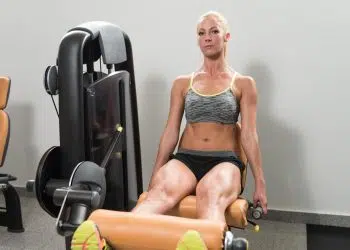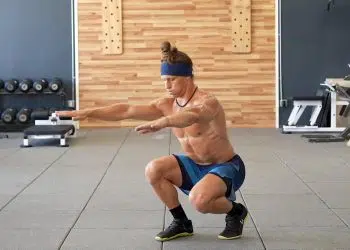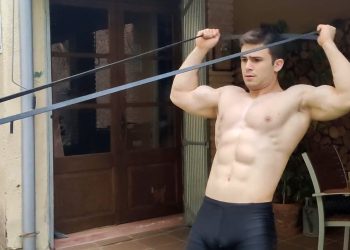Strength training is good for everybody’s body. Lifting weights builds stronger muscles, bones, and joints, can control your weight, and will improve your athleticism and functionality. This isn’t just my opinion; research also supports the long-term health and fitness benefits of strength training – especially for older adults (1).
I’m a veteran personal trainer with more than 30 years of professional experience and I train a wide range of clients, including bodybuilders, powerlifters, and athletes.
However, I also work with “average” folk who just want to get fit, stay healthy, and manage their weight. Some of these clients are relatively young but a growing number are in their 50s and beyond.
Needless to say, training such a wide variety of clients means using a range of different methods, and exercises that are perfect for one person are often completely unsuitable for another. Consequently, my 30-year-old bodybuilding clients are on very different programs from my over 50 moms!
In this article, I reveal the exercises that over 50s lifters should think twice about doing and what to do instead.
7 Exercises That Over 50s Lifters Should Probably Avoid and The Best Alternatives

Level Up Your Fitness: Join our 💪 strong community in Fitness Volt Newsletter. Get daily inspiration, expert-backed workouts, nutrition tips, the latest in strength sports, and the support you need to reach your goals. Subscribe for free!
I want to start this section with a disclaimer: I’m not saying that everyone over 50 should avoid all of the movements outlined below. So, if you can do these exercises with no problem, you enjoy them, and they match your training goals, there is no reason to give them up.
However, if you are a general exerciser who wants to reduce your risk of future injuries or experience discomfort due to your workout, these movements are generally best avoided.
When prescribing exercises for my clients, I weigh up my choices using a benefits-to-risk scale. If the risks outweigh the benefits, I look for better alternatives. This approach helps me keep my clients safe and free from injuries.
So, with that in mind, here’s my list of exercises that most over-50s lifters think twice about doing, and what to do instead.
1. Burpees
Burpees were invented in the 1930s by physiologist Royal H. Burpee Sr., as a way to test and develop fitness in the US Army. They’ve since been adopted by the wider fitness industry and are a common exercise in circuit training and HIIT workouts.
The burpee combines squats, squat thrusts, and push-ups to deliver a full-body workout that builds conditioning and burns kilocalories like a bonfire. It’s no wonder that they’re such a popular exercise.
However, burpees involve several factors that mean they may not be the best option for older exercisers, including very rapid movements and a whole lot of impact. This means the potential for knee, hip, lower back, and shoulder injuries is quite high.
I love burpees and have done thousands of them throughout my fitness career. However, I also recognize that they aren’t for everyone, and there are safer ways to build fitness and burn kilocalories.
Safer Alternatives to Burpees Include:
- Step-ups with weights
- Air-bike, rower, cross-trainer intervals
- Kettlebell swings
- Medicine ball slams
- Yoga sun salutations
2. Behind-the-Neck Lat Pulldowns
Go to any gym and you’ll probably see at least a few people doing behind-the-neck lat pulldowns. This old-school exercise works your upper back and biceps and is popular with bodybuilders and other hardcore lifters.
However, pulling the bar down behind your neck puts a lot of stress on your shoulder capsules which can lead to strain, pain, and injury.
Related: 13 Ways to Avoid Shoulder Pain in The Gym
This is because most people lack the mobility necessary to pull the bar down to the back of their necks. Invariably, performing this movement involves a whole bunch of neck contortions and shoulder wrenching.
Interestingly, research indicates that there is no muscular advantage to behind-the-neck vs. conventional lat pulldowns, and despite their higher risk, they do not deliver a more effective workout (2).
Safer Alternatives to Behind-The-Neck Lat Pulldowns Include:
- Conventional lat pulldowns
- Close grip lat pulldowns
- Pull-ups and chin-ups
- Band-assisted pull-ups
- Machine-assisted pull-ups
3. Behind-the-Neck Shoulder Press
Done seated or standing, the behind-the-neck shoulder press is another common bodybuilding exercise. It targets the deltoids, which are your main shoulder muscles.
Like behind-the-neck lat pulldowns, this exercise puts tremendous strain on the shoulder capsule and is a leading cause of joint pain and injury. In addition, many people lack the mobility needed to do behind-the-neck shoulder presses correctly and have to thrust their head forward to perform them. This can cause neck problems.
People who do this exercise believe that the behind-the-neck position emphasizes the medial or side deltoids, which are responsible for your shoulder width. This actually isn’t the case.
The medial deltoids are primarily responsible for lifting your arms out and away from the side of your body, a movement called abduction. Overhead presses, even with the bar behind your neck, are more of a shoulder extension exercise, which targets the anterior or front deltoids. The best way to work the medial delts is with cable or dumbbell lateral raises.
The good news is that there are lots of different overhead pressing exercises that are less risky than the behind-the-neck version.
Safer Alternatives to Behind-The-Neck Shoulder Presses Include:
- Dumbbell shoulder press
- Shoulder press machine
- Pike push-ups
- Barbell overhead press
- Cable shoulder press
4. Upright Rows
Upright rows have always been a somewhat controversial exercise. Some lifters think that they’re one of the best ways to build bigger shoulders and upper traps. Others view them as the ultimate shoulder destroyer.
I think they actually fall somewhere between these two points of view. Done with dumbbells or a rope handle and cable machine, some exercisers can do this move with no real issues. However, in my experience, the barbell variation is often problematic.
Level Up Your Fitness: Join our 💪 strong community in Fitness Volt Newsletter. Get daily inspiration, expert-backed workouts, nutrition tips, the latest in strength sports, and the support you need to reach your goals. Subscribe for free!
The inward rotation of the glenohumeral joint combined with driving the head of the humerus into the shoulder socket can cause wear and tear and shoulder pain, especially in older exercisers. Consequently, I tend to avoid giving this movement to my over-50s training crew.
Instead of upright rows, I prefer to train the deltoids and upper trapezius separately. While this does mean prescribing more exercises, the lower risk of injury and shoulder pain makes this small inconvenience worth the cost.
Safer Alternatives to Upright Rows Include:
- Dumbbell shrugs
- Trap bar shrugs
- Barbell shrugs
- Dumbbell lateral raise
- Victory raises
5. Barbell Bent-Over Rows
Barbell bent-over rows work your upper back, mid-back, and biceps. It’s a popular exercise and it can be an effective muscle and strength builder. However, the bent-over row has a dark side – it can also cause severe lower back strain and pain.
That’s because the bent-over row involves unsupported forward flexion which puts a lot of stress on your lumber vertebrae, intervertebral disks, and spinous ligaments.
These structures, if injured, take a long time to heal, and damaging them can cause crippling lower back pain. Low back pain affects all ages but studies suggest is more prevalent in older people (3).
So, while the barbell bent-over row and its close cousin the T-bar row are both popular and effective exercises, I don’t think they’re worth the risk if you are an over-50s lifter. There are plenty of safer ways to build a strong, shapely back.
Safer Alternatives to Barbell Bent-Over Rows Include:
https://youtu.be/AW15pbjMlhA?si=41HaYFzlm_c4RnlR
6. Barbell Bench Press
The barbell bench press is probably the most popular chest exercise. Powerlifters and bodybuilders do it, and it’s a favorite among most recreational lifters, too. Get two exercisers together and, invariably, one will ask the other, “Bro – how much can you bench?”
However, despite its widespread popularity, the bench press is a problematic exercise that often causes shoulder problems. Bench presser’s shoulder is a common ailment among lifters.
The main problem with the bench press is actually the bench. Lying on the bench inhibits your scapulae or shoulder blades so they cannot move freely. This means your shoulder joint has to extend abnormally as you lower the bar to your chest.
This puts a lot of stress on your shoulder capsule which, if you’ve been lifting for more than a few years, is probably already showing signs of wear and tear.
Shoulder pain is no one’s idea of fun, and it can make training the rest of your body uncomfortable, if not impossible. Consequently, it’s generally best to avoid any exercise that increases the risk of painful shoulder joints.
That’s not to say you should stop training your chest when you hit your 50s – forget that idea! However, you may want to drop the bench press and switch to a more joint-friendly exercise.
Safer Alternatives to Barbell Bench Press Include:
- Floor press
- Stability ball dumbbell chest press
- Svend press
- Push-ups
- Cable chest press
7. Barbell Back Squats
The final exercise on my lift of movements to avoid in your 50s and beyond is a controversial choice, especially given my past powerlifting history. After all, the barbell back squat is often called the king of exercises, and entire workouts have been written around it, such as the classic 20-rep squat routine.
However, while I believe that almost everyone should include squats in their workouts, I’m not convinced that doing them with a barbell on your back is the way to go.
That’s because resting a barbell on your shoulders creates a long lever which puts a tremendous load on your lower back. This load increases if your pelvis tilts posteriorly as you squat, a common form fault known as “butt wink.”
A history of prolonged sitting, muscle tightness, reduced core strength, and poor posture means that many over 50s exercisers cannot do barbell back squats with the technique necessary to prevent injury.
Rather than strengthen their legs, this exercise becomes a notorious backbreaker. Needless to say, back pain can prevent you from exercising, and missed workouts will negate any benefits gained from back squats.
That’s not to say all squats should be avoided. In fact, there are plenty of squat-based movements I use with my clients. The benefits of back squats, however, are generally not worth the risk.
Safer Alternatives to Barbell Back Squats Include:
Closing Thoughts
When I was studying to become a personal trainer (over 30 years ago!) I was taught that some exercises are contraindicated, meaning they should be avoided at all costs. I soon came to realize that this was an oversimplification and that every exercise should be prescribed based on the client’s needs, goals, and abilities.
That said, those needs, goals, and abilities change as you get older, and that means exercises that used to be okay when you were in your 20s and 30s may be less suitable as you move into your 40s, 50s, and beyond.
In my experience, exercises like barbell back squats, behind-the-neck lat pulldowns, and barbell bent-over rows offer more risks than benefits. Consequently, I tend to prescribe safer alternatives to my over-50s clients. This helps keep free from injury while still building or maintaining muscle and strength.
Whatever you are training for, you’ll get better results if your workouts are consistent, so it makes nothing but sense to avoid unnecessarily risky exercises. Use the listed alternatives to keep your workout on track while avoiding unwanted aches and pains.
Is there an exercise you can no longer do or that you feel is unnecessarily dangerous? Tell me about it in the comments section below.
References:
- Hart PD, Buck DJ. The effect of resistance training on health-related quality of life in older adults: Systematic review and meta-analysis. Health Promot Perspect. 2019 Jan 23;9(1):1-12. doi: 10.15171/hpp.2019.01. PMID: 30788262; PMCID: PMC6377696.
- Padovan R, Toninelli N, Longo S, Tornatore G, Esposito F, Cè E, Coratella G. High-Density Electromyography Excitation in Front vs. Back Lat Pull-Down Prime Movers. J Hum Kinet. 2024 Apr 15;91(Spec Issue):47-60. doi: 10.5114/jhk/185211. PMID: 38689585; PMCID: PMC11057623.
- de Souza IMB, Sakaguchi TF, Yuan SLK, Matsutani LA, do Espírito-Santo AS, Pereira CAB, Marques AP. Prevalence of low back pain in the elderly population: a systematic review. Clinics (Sao Paulo). 2019 Oct 28;74:e789. doi: 10.6061/clinics/2019/e789. PMID: 31664424; PMCID: PMC6807687.









Excellent article! I think I got a hernia from leg lifts. M68 may just be age. I’m afraid to exercise now so I walk and hike up and down more. Thank you!
Hey Gabe – thanks for the kind words.
Sorry to hear about your hernia – tough break. Leg raises can be brutal so they may have caused your hernia. Maybe (with your Dr’s ok) start doing some gentle bracing exercises such as quadruped abs pull-in, keeling planks, or just tensing your abs whenever you have a few minutes spare to start strengthening your core again. Otherwise the muscles will get even weaker, making re-injury more likely.
Take it from an older fella – you don’t have to be afraid to exercise, but you definitely need to treat your body with a bit more care and attention – like a classic automobile! It’s all about finding your comfort level and doing your best to keep things moving. The less you do, the less you’ll be able to do in the future.
Keep up with the hiking – great workout. Add some weight and try rucking to build some extra leg strength if you can.
Good look, man.
Patrick.
Hello Pat. I really enjoy your articles, especially for us older folks like this one. As a fit 72 year old with lower back problems, I would like your thoughts on using a back brace during exercising. I sometimes need to quit too soon on exercises not even related to the back because of strain on two collapsed disks. Thanks.
Hey Gary – thanks for the kind words!
Re. lower back pain and using a back brace, provided it doesn’t lead to overexertion and making any existing issues worse, I can see no real reason not to use one. After all, NOT exercising may exacerbate the condition.
That said, I recommend discussing your back pain with a medical doctor or physical therapist to determine if a back brace is the best solution for you.
It may also be worth exploring other forms of exercise to see if you can find something that doesn’t aggravate your back. For e.g., if walking is an issue, as it can be for some low back pain sufferers, maybe try swimming or stationary biking.
I hope that’s help and wish you all the best with your continuing fitness endeavors.